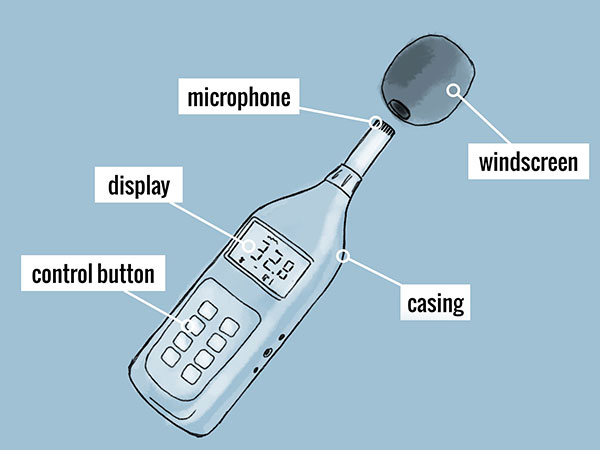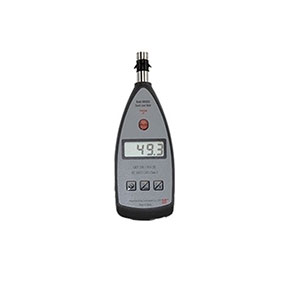What is a Sound Level Meter?
A sound level meter is a fundamental tool for measuring noise; it is an electronic instrument distinct from objective electronic instruments like voltmeters. When converting sound signals into electrical signals, it simulates the time characteristics of the human ear's response to sound waves: frequency characteristics with different sensitivities to high and low frequencies and intensity characteristics that change with different loudness levels. Therefore, a sound level meter is a subjective electronic instrument. In this article, ATO industrial automation will introduce the basic information about the sound level meter (including its structure, working principle and applications) for you.
Structure of a Sound Level Meter
A sound level meter consists of a microphone, amplifier, attenuator, weighting network, detector, indicator head, and power supply, among other components.
- Microphone
It is the device that converts sound pressure signals into voltage signals, also known as a microphone. Common types of microphones include crystal, electret, dynamic, and capacitor types. - Amplifier and Attenuator
Many domestically produced and imported devices use a two-stage amplifier in the amplification circuit, namely an input amplifier and an output amplifier. Their role is to amplify weak electrical signals. Input and output attenuators are used to adjust the attenuation of the input and output signals, ensuring that the pointer on the indicator head points to the appropriate position, with each step corresponding to a 10-decibel attenuation. The attenuation range of the input attenuator is for measuring the lower end (e.g., 0~70 decibels), while the output attenuator's range is for measuring higher levels (70~120 decibels). The scales of the two attenuators are often made in different colors, commonly black paired with transparent. Since many sound level meters use 70 decibels as a limit, care should be taken not to exceed this limit during rotation to avoid damage to the device.
- Weighting Network
To simulate the different sensitivity of the human ear to different frequencies, a weighting network is built inside the meter. It corrects the electrical signal to a network that approximates the perception of the ear. This network is called a weighting network. The sound pressure level measured through the weighting network is no longer the linear sound pressure level of the objective physical quantity; it is the perceived and corrected sound pressure level, known as the weighted sound level or noise level.
According to IEC standards, several curves close to the frequency response of the human ear to sound are selected, and four standard weighting networks—A, B, C, and D—are designed. The A-weighted network's frequency response curve is roughly equivalent to the inverted curve of the 40-phon equal loudness curve, resulting in significant attenuation in the mid- to low-frequency range and some attenuation in the high-frequency range. The B-weighted network is roughly equivalent to the inverted curve of the 70-phon equal loudness curve, providing certain attenuation in the low-frequency range. The C-weighted network is equivalent to the inverted curve of the 100-phon equal loudness curve, exhibiting nearly flat response throughout the entire audio frequency range, approximately matching the ear's response to high-frequency sound. Readings obtained through A, B, C, and D weighting networks are called sound levels, which are sound pressure levels after frequency weighting, distinct from sound pressure levels.
The frequency response of A-weighting is adapted to the sensitivity of the human ear to a wide range of frequency sounds, making it widely used in practical measurements. D-weighting networks are commonly used for measuring aviation noise. - Detector and Indicator Head
To display the amplified signal through the indicator head, a detector is required to convert rapidly changing voltage signals into slowly changing DC voltage signals. The magnitude of this DC voltage is proportional to the size of the input signal. Depending on measurement needs, detectors are categorized as peak detectors, average detectors, and root mean square (RMS) detectors. Peak detectors provide the maximum value over a certain time interval, average detectors measure the average value over a specific time interval, and RMS detectors measure the root mean square value.
Working Principle of a Sound Level Meter
The microphone converts sound into electrical signals, and the front amplifier changes the impedance to match the microphone with the attenuator. The amplifier adds the output signal to the weighting network, which applies frequency weighting (or an external filter). The signal is then further amplified to a certain amplitude by the attenuator and amplifier before being sent to the effective value detector (or an external level recorder). The indicator head displays the numerical value of the noise sound level. To simulate the different sensitivity of the human ear to different frequencies (20Hz-20KHz), a weighting network is built into the sound level meter to correct the electrical signal to a network that approximates the perceived value, called a weighting network. The sound pressure level measured through the weighting network is no longer the linear sound pressure level of the objective physical quantity (called linear sound pressure level) but the perceived and corrected sound pressure level, known as the weighted sound level or noise level.
Applications of Sound Level Meters
- Environmental Noise Monitoring:
Sound level meters can be used to measure noise levels in the environment, such as urban traffic noise, industrial equipment noise, construction site noise, etc. This helps assess the impact of noise on human health and the environment and take corresponding measures to control noise pollution. - Industrial Safety and Health:
Sound level meters can assess the noise levels in industrial settings to ensure the hearing safety of workers. They can help determine whether measures need to be taken to reduce noise exposure, such as providing earplugs or earmuffs, and optimizing workplace design to lower noise levels. - Entertainment Venue Management:

Sound level meters can measure the noise levels generated by music or performances in entertainment venues such as concert halls, theaters, nightclubs, etc. This helps ensure that the venue's volume is within an acceptable range, avoiding damage to the hearing health of the audience or staff. - Architectural Design and Planning:
Sound level meters can be used to assess the sound insulation effectiveness of buildings, ensuring control over noise transmission between internal or adjacent areas of a building. This is crucial for designing residential areas, offices, schools, hospitals, etc., to provide a comfortable and quiet environment. - Environmental Impact Assessment:
Sound level meters can be used in environmental impact assessments to measure the noise impact of engineering projects, construction projects, or infrastructure projects (such as highways, airports, etc.) on the surrounding environment. This helps assess project feasibility, predict and take measures to reduce noise interference on surrounding residents or the natural environment.
In summary, a sound level meter is a crucial tool for measuring and assessing sound intensity. From environmental monitoring to occupational safety, its ability to quantify noise levels contributes to managing noise pollution and ensuring compliance with regulations. As technology advances, these instruments evolve to provide more comprehensive insights into acoustic environments, promoting healthier and safer living and working spaces.

